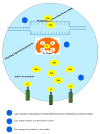Role of Zinc (Zn) in Human Reproduction: A Journey from Initial Spermatogenesis to Childbirth
- PMID: 33671837
- PMCID: PMC7926410
- DOI: 10.3390/ijms22042188
Role of Zinc (Zn) in Human Reproduction: A Journey from Initial Spermatogenesis to Childbirth
Abstract
Zinc (Zn), the second-most necessary trace element, is abundant in the human body. The human body lacks the capacity to store Zn; hence, the dietary intake of Zn is essential for various functions and metabolism. The uptake of Zn during its transport through the body is important for proper development of the three major accessory sex glands: the testis, epididymis, and prostate. It plays key roles in the initial stages of germ cell development and spermatogenesis, sperm cell development and maturation, ejaculation, liquefaction, the binding of spermatozoa and prostasomes, capacitation, and fertilization. The prostate releases more Zn into the seminal plasma during ejaculation, and it plays a significant role in sperm release and motility. During the maternal, labor, perinatal, and neonatal periods, the part of Zn is vital. The average dietary intake of Zn is in the range of 8-12 mg/day in developing countries during the maternal period. Globally, the dietary intake of Zn varies for pregnant and lactating mothers, but the average Zn intake is in the range of 9.6-11.2 mg/day. The absence of Zn and the consequences of this have been discussed using critical evidence. The events and functions of Zn related to successful fertilization have been summarized in detail. Briefly, our current review emphasizes the role of Zn at each stage of human reproduction, from the spermatogenesis process to childbirth. The role of Zn and its supplementation in in vitro fertilization (IVF) opens opportunities for future studies on reproductive biology.
Keywords: cellular metabolism; human reproduction; male infertility; seminal plasma; zinc.
Conflict of interest statement
The authors declared “No conflict of interest”.
Figures


Similar articles
-
The biology of human male reproduction: an overview.Am J Ind Med. 1983;4(1-2):5-15. Am J Ind Med. 1983. PMID: 6404164 Review.
-
An overview on role of some trace elements in human reproductive health, sperm function and fertilization process.Rev Environ Health. 2019 Dec 18;34(4):339-348. doi: 10.1515/reveh-2019-0008. Rev Environ Health. 2019. PMID: 31203261 Review.
-
Effects of zinc deficiency on impaired spermatogenesis and male infertility: the role of oxidative stress, inflammation and apoptosis.Hum Fertil (Camb). 2020 Apr;23(1):5-16. doi: 10.1080/14647273.2018.1494390. Epub 2018 Aug 21. Hum Fertil (Camb). 2020. PMID: 30129823 Review.
-
Zinc and Its Impact on the Function of the Testicle and Epididymis.Int J Mol Sci. 2024 Aug 19;25(16):8991. doi: 10.3390/ijms25168991. Int J Mol Sci. 2024. PMID: 39201677 Free PMC article. Review.
-
The role of molecular chaperones in spermatogenesis and the post-testicular maturation of mammalian spermatozoa.Hum Reprod Update. 2012 Jul;18(4):420-35. doi: 10.1093/humupd/dms009. Epub 2012 Apr 20. Hum Reprod Update. 2012. PMID: 22523110 Review.
Cited by
-
Modulation of TvRAD51 Recombinase in Trichomonas vaginalis by Zinc and Cadmium as a Potential Mechanism for Genotoxic Stress Response.Pathogens. 2025 Jun 5;14(6):565. doi: 10.3390/pathogens14060565. Pathogens. 2025. PMID: 40559573 Free PMC article.
-
Effects of Dietary Zinc Deficiency and Supplementation on Prepubertal Rat Testes: Sulfhydryl and Antioxidant Status.Indian J Clin Biochem. 2024 Oct;39(4):539-547. doi: 10.1007/s12291-023-01167-8. Epub 2023 Dec 28. Indian J Clin Biochem. 2024. PMID: 39346712
-
Influence of Seminal Metals on Assisted Reproduction Outcome.Biol Trace Elem Res. 2023 Mar;201(3):1120-1134. doi: 10.1007/s12011-022-03256-w. Epub 2022 May 11. Biol Trace Elem Res. 2023. PMID: 35543968 Free PMC article.
-
Jiawei Runjing Decoction Improves Spermatogenesis of Cryptozoospermia With Varicocele by Regulating the Testicular Microenvironment: Two-Center Prospective Cohort Study.Front Pharmacol. 2022 Aug 9;13:945949. doi: 10.3389/fphar.2022.945949. eCollection 2022. Front Pharmacol. 2022. PMID: 36016555 Free PMC article.
-
Effects of short term dietary zinc deficiency and zinc supplementation on nitro-oxidative stress in testes of Wistar rats.Biometals. 2025 Apr;38(2):587-596. doi: 10.1007/s10534-025-00666-w. Epub 2025 Feb 10. Biometals. 2025. PMID: 39930252
References
-
- Shukla A.K., Tiwari P.K., Pakhare A., Prakash C. Zinc and iron in soil, plant, animal and human health. Indian J. Fertil. 2016;12:133–149.
-
- Prasad A.S. Metabolism of Trace Metals in Man Volume I (1984): Developmental Aspects. CRC Press; New York, NY, USA: 2017. Trace metals in growth and sexual maturation.
-
- World Health Organization . Global Status Report on Alcohol and Health 2018. World Health Organization; Geneva, Switzerland: 2019.
-
- Kovacik A., Tirpak F., Tomka M., Miskeje M., Tvrda E., Arvay J., Fik M. Trace elements content in semen and their interactions with sperm quality and RedOx status in freshwater fish Cyprinus carpio: A correlation study. J. Trace Elem. Med. Biol. 2018;50:399–407. doi: 10.1016/j.jtemb.2018.08.005. - DOI - PubMed
Publication types
MeSH terms
Substances
LinkOut - more resources
Full Text Sources
Other Literature Sources

